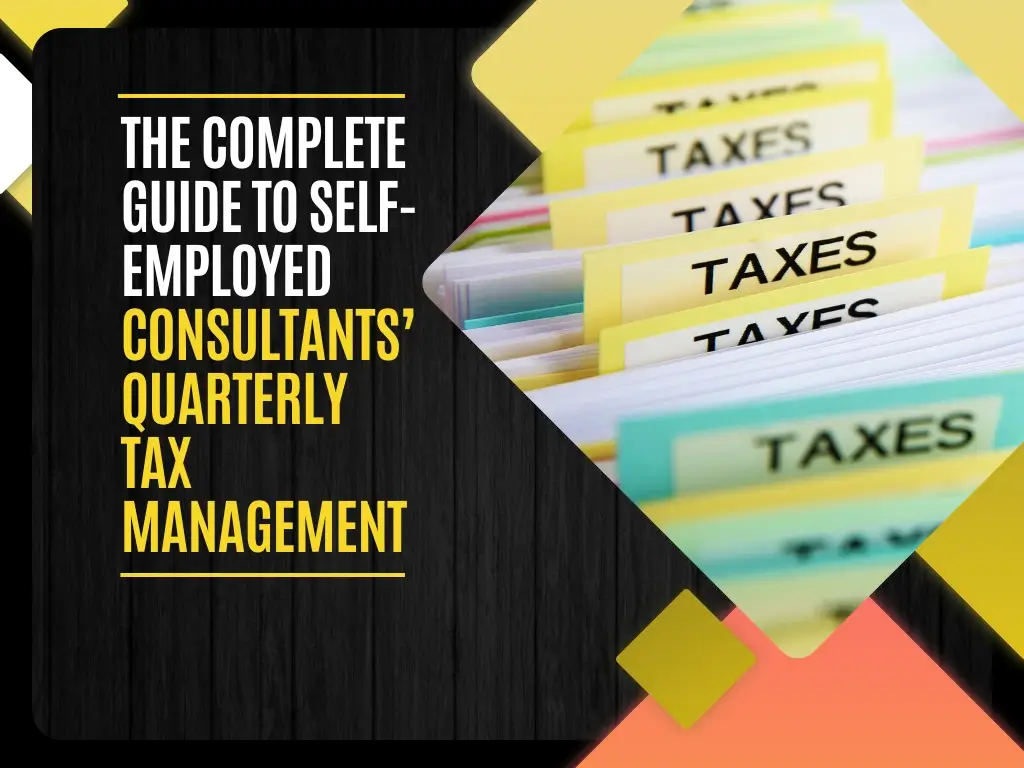The Complete Guide to Self-employed Consultants’ Quarterly Tax Management
Learn how self-employed consultants can effectively manage quarterly taxes with this complete guide on planning, filing, and saving money.

As an independent consultant, navigating the financial landscape can be both lucrative and difficult. Understanding and filing your taxes on a quarterly basis is one of the most important parts of managing your finances. Freelancers and business owners have to handle taxes more proactively than regular employees do. With the help of this extensive book, you will get the knowledge and skills necessary to efficiently handle your quarterly taxes, optimize your tax savings, and maintain IRS compliance.
An Explanation of Quarterly Tax Payments
It is your responsibility as an independent contractor or freelancer to pay your taxes to the Internal Revenue Service directly. This includes Medicare and Social Security taxes as well as your income tax from self-employment. In order to avoid penalties and interest costs, the IRS mandates that you make these payments on a quarterly basis.
The following are the dates that the IRS has projected for 2024 tax payments:
15 April 2024; 17 June 2024; 16 September 2024; 15 January 2025
You must follow these dates to make sure you file your taxes on time and keep your good status with the IRS.
How to Determine Your Tax Payments Each Quarter
Use a self-employed tax calculator to determine how much you have to pay each quarter. You can use this calculator to estimate your taxes by entering your income, the allowable deductions, and other pertinent information. Here’s how to calculate your quarterly tax payments, step-by-step:
- Assess Your Annual Income: Find out how much you anticipate earning annually. This covers every revenue stream associated with your consulting practice.
- Deduct Business Expenses: To calculate your net income, deduct any costs associated with your business from your gross income. Deductions for things like office supplies, travel costs, and expert services are common.
- Calculate Self-Employment Tax: To determine your self-employment tax liability, use the self-employed tax calculator. This tax, which is deducted from your net income and accounts for Medicare and Social Security, is approximately 15.3%.
- Calculate Income Tax load: Determine your federal income tax burden based on your net income. You can estimate this amount with the use of the self-employed tax calculator, which takes into account your filing status and any available tax credits.
- Divide by Four: To calculate your quarterly tax payments, divide the total amount of projected tax due for the year by four.
Encouraging Tax Benefits
It can be difficult for independent contractors and business owners to maximize their tax benefits. Nevertheless, you can drastically lower your tax bill by utilizing the credits and deductions that are available to you. Here are some tactics to think about:
- Keep Track of Every Business Expense: Maintain precise records of all business-related expenses. This covers bank statements, invoices, and receipts. Accounting software can facilitate and expedite this procedure.
- Home Office Deduction: You might be able to claim this deduction if you work from home. This lets you write off a portion of your rent, utilities, mortgage, and other housing-related costs.
- Retirement Contributions: You can lower your taxable income and save for the future by making contributions to a retirement plan, such as a Solo 401(k) or SEP IRA.
- Health Insurance payments: Self-employed individuals may deduct the cost of their family’s and personal health insurance. Significant financial savings may result from this, particularly for those whose premiums are high.
- Education and Training: Expenses for professional development and ongoing education are deductible. This involves attending conferences, taking training classes, and earning credentials that raise your proficiency level.
- Mileage and Vehicle Expenses: You may write off actual mileage or vehicle costs if you drive your own vehicle for work. To get the most out of your investment, keep a thorough record of all your business trips.
Encouraging Income Tax Returns Every Quarter
It’s time to file your taxes with the IRS on a quarterly basis after you’ve estimated them. Here’s how to make sure that everything goes smoothly throughout the filing procedure, step-by-step:
- Fill out Form 1040-ES completely: You declare your estimated tax payments on this form. It can be downloaded from the IRS website or filled out electronically using tax software.
- Submit Payments Online or by Mail: You have multiple options for delivering your quarterly tax payments to the IRS. You can pay in three different ways: over the phone, via IRS Direct Pay, or by mailing Form 1040-ES together with a check or money order.
- Preserve Payment Records: Ensure that you have copies of all invoices and confirmation numbers of payments. Tracking your payments and balancing your tax records at the end of the year depend on this paperwork.
- Adjust Payments as Needed: You might need to modify your quarterly payments if your income varies over the year. To make sure your payments appropriately reflect your income, use the self-employed tax calculator on a regular basis.
Typical Mistakes and How to Prevent Them
Managing quarterly taxes can be difficult, and many business owners and independent contractors make typical mistakes. Here’s how to stay away from them:
- Underestimating Income: You risk fines for underpayment if you estimate your income incorrectly. Review your revenue on a regular basis and adjust your estimates as needed.
- Missing Payment Deadlines: Penalties and interest charges may apply if you fail to make a payment by the IRS’ estimated tax payment deadlines for 2024. To ensure that entries are made on time, set reminders for each payment deadline.
- Neglecting Deductions: Your tax liability may rise if you fail to claim all of your allowable deductions. Remember to keep track of any possible deductions and save all the supporting evidence for your claims.
- Not Setting Aside Funds: Cash flow problems may arise if money is not set aside for tax payments. To make sure you have the money on hand to pay your taxes, think about opening a new savings account.
Getting Help from a Professional
Even though you can handle your own quarterly taxes, hiring a professional can help you more. A tax expert like Asena Advisors can guide you through the intricate maze of tax laws, point out possible deductions, and make sure you abide by IRS regulations. Here are several justifications for thinking about seeing a tax expert:
- Expertise and Knowledge: Tax experts possess a deep comprehension of tax laws and guidelines. They might offer insightful analysis and helpful advice on how to optimize your tax savings.
- Time Savings: The process of filing taxes takes a lot of time. Hiring an expert ensures accurate and effective tax administration while letting you concentrate on your business.
- Peace of Mind: Having your taxes handled by a tax expert allows you to sleep easily knowing that your case is in good hands. By doing this, you can lessen your worry and stay clear of any IRS problems.
- Audit Support: A tax expert can act as your representative during an audit and offer the supporting documents and evidence required to address any problems.
Verdict
As an independent consultant, handling quarterly taxes demands meticulous planning and attention to detail. You may minimize your tax obligations and increase your savings by being aware of the procedure, using resources like a self-employed tax calculator, and utilizing all of the deductions that are accessible to you. Recall to research the IRS estimated tax payment dates 2024 and, should expert aid be needed, to obtain it. If you make the correct decision, you may focus on expanding your consulting company while handling the difficulties posed by quarterly taxes.



